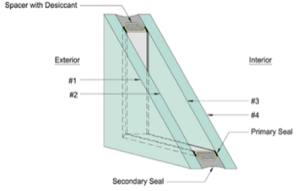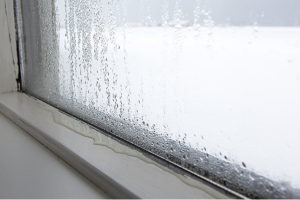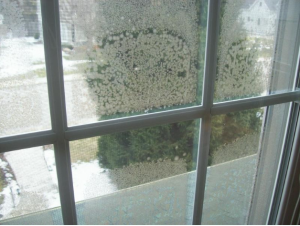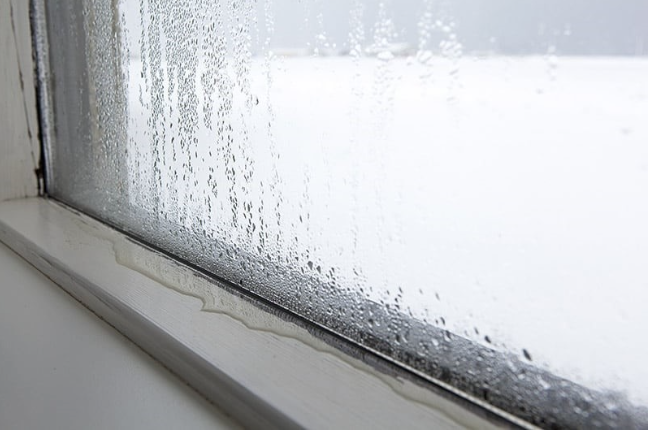Insulated Units 101: Distinguishing Between Condensation and Seal Failure
By: Nathan Gason
Curious about foggy windows? In this post, we’ll delve into the various causes of fog and condensation on windows, providing insights into what it means and what actions to take. The primary focus is to assist homeowners and business owners who may observe condensation on their Insulated Glass (IG) units and are uncertain about whether it warrants concern.
Before we delve into the essentials of condensation, let’s clarify some terminology. For the purposes of this blog, condensation will encompass any moisture accumulation on the glass of an insulated unit. This includes both the fogginess that occasionally manifests on a window and larger droplets akin to dew. The precise location of condensation on the window is crucial, and we will briefly outline the various surfaces of an IG.

An IG comprises two pieces of glass with air in between, resulting in four technically distinct surfaces. Each of the two glass panes has two sides. Surface 1 is the window’s exterior and surface 2 is the opposite side of that pane> Surface 3 is the first side of the second pane (inside the IG), and surface 4 is the interior side of the unit.
To illustrate, if an IG were installed in your house, Surface 1 would be the side accessible from your yard, surfaces 2 and 3 would be within the window, and surface 4 would be the side facing the interior of your home. Lastly, it’s worth noting that IG stands for insulated glass unit and will be used interchangeably with ‘window’ throughout this blog, specifically referring to the glass unit comprising the window.
Condensation on Surfaces 1 & 4 (External Condensation)
Condensation on surfaces 1 or 4 is not inherently harmful, but it can indicate an underlying issue. Therefore, understanding how and why it occurs is crucial for addressing it effectively.
Imagine waking up on a cool morning to dewdrops on the lawn. This happens when water condenses from the air onto colder surfaces, such as the ground, cold drinks, or, of course, cold windows. Therefore, if you find condensation on surface 4 of your Insulated Glass (IG), it is no more concerning than dew on your lawn. However, if you prefer a clearer view from your window on cold mornings, there are solutions. If your windows are shaded by tall bushes and shrubbery, consider trimming them to allow sunlight to reach your windows. Sunlight will warm up the window, preventing the formation of water droplets on cool surfaces. Additionally, we offer warm edge spacers at NWGF, made of foam instead of metal. Unlike metal, foam does not conduct heat as effectively, keeping the edges of your panes warmer (hence ‘warm edge’ spacer) and preventing condensation, similar to trimming shrubbery.

Condensation on surface 1of the IG is more complex. As mentioned earlier, condensation forms on the outside of windows, similar to a cold can of soda. Water droplets emerge from the air and form on colder surfaces. If this occurs inside your home or business, it suggests either the indoor air is significantly warmer than the window or the space is relatively humid. Wet and humid air can lead to rot and mold in walls. Regular condensation on the inside may indicate a humidity issue. To address this, consider using a dehumidifier, which can be fairly inexpensive depending on size. It reduces the water content in the air, preventing it from forming droplets on your IG. Alternatively, if the outside air is drier than inside, leaving your window open can help. This allows wetter air to exit and drier air to enter, though this approach depends on weather conditions, as leaving the window open may introduce other problems beyond condensation.
Condensation Inside the IG (Surfaces 2 & 3)
Condensation on the inside of the IG is more critical than external condensation. Since a window functions as a closed system, the presence of moisture on surfaces 2 or 3 indicates a failure in the seal between the panes of glass at one or more locations. To identify the surface where moisture is accumulating, a process of elimination is the most effective method. If you have cleaned surfaces 1 & 4, and moisture is still visible, it must be on surfaces 2 or 3. Another method is through the observation of speckled low-e. Low-e applied to some IGs to regulate temperature, can become speckled when condensation forms on surfaces 2 or 3, damaging the low-e coating on that surface. As condensation fluctuates based on relative humidity and other factors, these speckles persist in the low-e and serve as a reliable indicator of a failed seal.
Unfortunately, there is no easy fix once a seal has failed. The window will need to be replaced entirely, incurring potential costs. Fortunately, at NWGF, we stand behind the quality of our products. Our mill spacer units come with a 10-year warranty that covers seal failure. This ensures that our customers can be confident in the longevity of their window units, keeping moisture out for years to come.

Final Thoughts
Now equipped with knowledge about condensation, its formation, and appropriate actions, you’ve become an expert! Remember, condensation serves as a symptom of moisture and colder surfaces. If it occurs indoors, contemplate using a dehumidifier. When it happens outdoors, ensure your window receives ample sunlight. Lastly, if condensation appears within the insulated glass unit, it’s time to consider a new window. Should you suspect seal failure or the need for a replacement, do consider NWGF where out 10-year warranty will provide you peace of mind on your investment.
For inquiries about our warranty or products, our Customer Support Team is always available to assist you! Reach out to us through our website or give us a call at 763-762-1750.
Sources:
- https://www.pella.com/ideas/windows/window-condensation-tips/
- https://homespireforlife.com/blog/condensation-the-red-flag-of-window-insulation-quality/
- https://www.bobvila.com/articles/condensation-on-windows/
- Personal Interview with Elliot McCarty, Quality & Safety Coordinator for Brin Glass Companies.
- https://www.aiglass.com/insulating-glass.html



Project Manager – Metal
Inside Sales and Client Support Manager
Glass Handler – 1st Shift